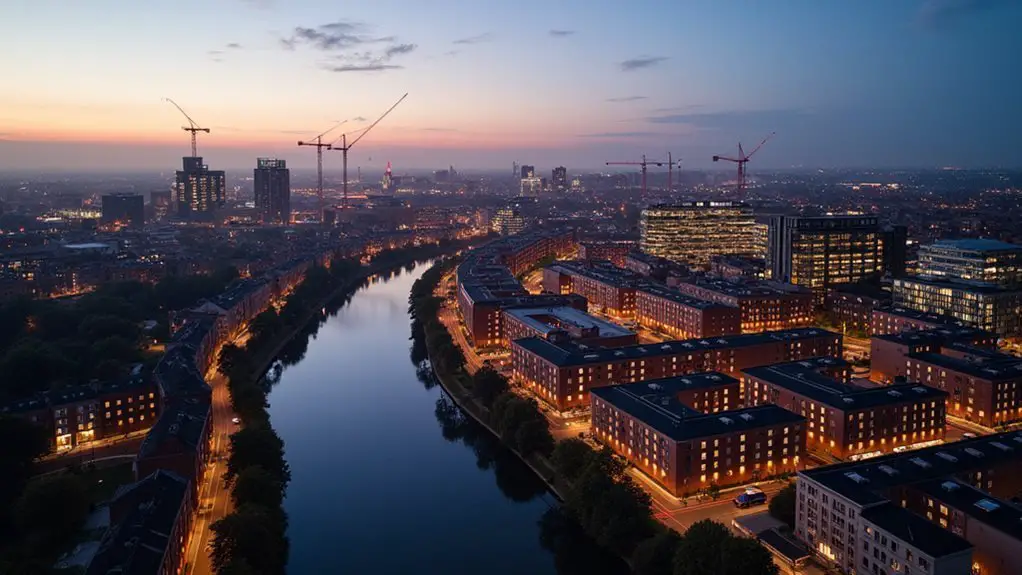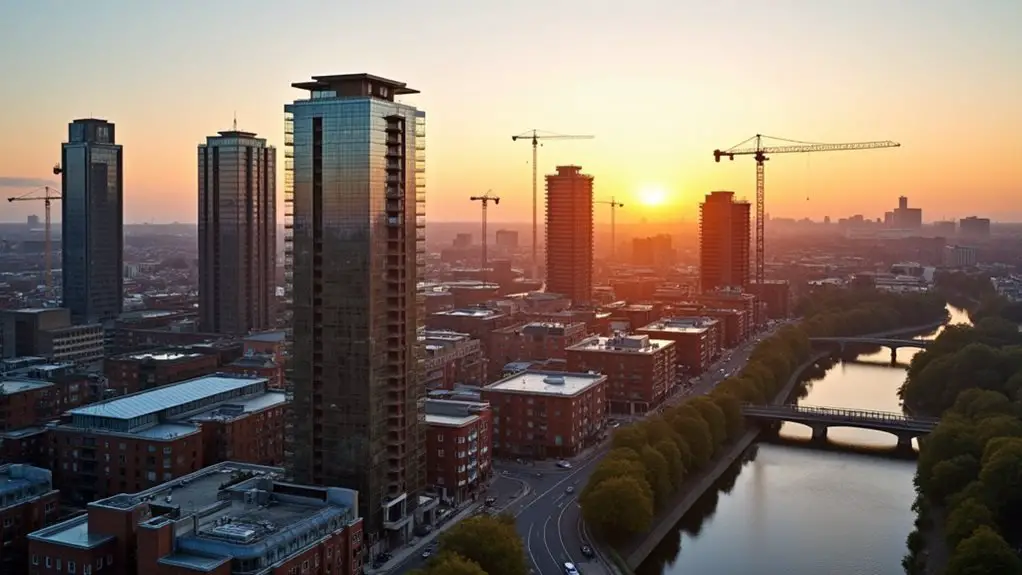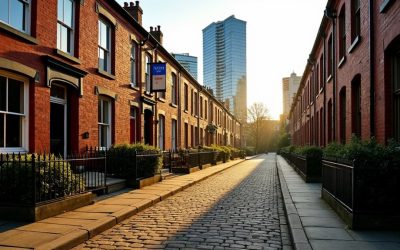Leeds offers compelling investment opportunities with projected 2.1% annual economic growth and a 21% property value increase by 2026. You'll find average property values of £271k, with strong performance in the £150k-£200k range and attractive rental yields averaging 4.94%. The city's diverse economy, contributing £69.6 billion annually to the UK, supports market stability. Prime investment areas include LS4 (Burley and Kirkstall) with 7.8% yields and LS2 district at 6.3%. Major developments like the £500 million South Bank project, delivering 8,000 new homes and 35,000 jobs, signal Leeds' transformation into an even more lucrative investment destination. The following insights will equip you with strategic advantages for maximizing returns.
Why Choose Leeds for Investment

Leeds stands out as one of the UK's most promising investment destinations, backed by its remarkably diverse economy and impressive growth projections. You'll find the city's economic stability particularly compelling, with projected growth of 2.1% annually and an additional £1.5 billion expected in GVA by 2026. This robust foundation creates numerous property advantages for investors looking to expand their portfolios.
When you're considering investment locations, you'll appreciate that Leeds isn't overly dependent on any single industry. The city's diverse economic landscape, spanning finance, healthcare, and technology sectors, employs around 320,000 professionals and generates an impressive £20 billion in economic output. The city's lower property prices compared to other major UK cities make it an attractive investment choice. With average house prices in Leeds City Centre at £187,879, the market remains accessible to investors. This diversification helps protect your investment against sector-specific downturns.
What's particularly attractive is Leeds' remarkable employment growth rate of 1.4% annually, outpacing both national and regional averages. Combined with major regeneration projects and a thriving rental market yielding 4.94% on average, you're looking at a city that's perfectly positioned for property investment.
The South Bank project alone, with its promise of 8,000 new homes and 35,000 jobs, demonstrates Leeds' commitment to sustainable growth and development.
Leeds Property Market Overview
When you're looking at Leeds' property market, you'll find a compelling mix of stability and growth potential, with average property values of £271k and particularly strong performance in the £150k-£200k range.
You'll notice the market's resilience through recent challenges, as evidenced by the gradual return to pre-pandemic activity levels and the increasing confidence among buyers and sellers. The latest data shows 1,402 new listings in Leeds postcodes LS1-LS12 during Q1 2024. Office leasing activity has been particularly robust, with 350,000 sq ft of take-up in the first half of 2024 exceeding both five-year and ten-year averages.
While the city's 2% price decline over the past year might raise concerns, it's worth considering this adjustment as an opportunity, especially given the robust rental market where rates have surged by 42% since 2020.
Market Growth and Values
The property market in West Yorkshire's largest city presents compelling evidence of long-term growth, with values increasing by 57% over the past decade from £131,526 to £207,501. Despite recent market challenges, Leeds continues to demonstrate robust market demand, with 1,198 properties sold in Q2 2024 and consistent pricing trends in the £150,000 to £200,000 range. The high activity in this price bracket is evident with 332 new listings appearing in Q2 2024. Properties in Leeds demonstrate significant buyer interest, with each rental listing receiving 30 enquiries on average.
You'll find Leeds' investment potential particularly promising, with projections indicating a 20.2% value increase between 2024 and 2028. The city's ambitious South Bank regeneration project, set to deliver 8,000 new homes and create 35,000 jobs, will likely drive further growth in property values.
Current market data shows average asking prices of £240,857, though you'll want to note the importance of realistic pricing strategies to secure successful sales.
When considering rental investments, you're looking at attractive yields of 4.94%, surpassing the national average of 4.75%. With average rents at £1,087 PCM and showing a 7.7% annual increase, Leeds offers compelling opportunities for both capital appreciation and rental income, supported by its growing population of almost 800,000 residents.
Investment Returns By Area
Building on these promising market trends, specific neighborhoods across Leeds offer distinctly different investment returns.
You'll find the highest yields in areas like LS4 and LS9, where student demand and affordable property prices drive returns of 7.8% and 8.5% respectively. LS9's excellent transport links make it particularly attractive to tenants, while LS4's Burley and Kirkstall areas continue drawing young professionals and students alike. Economic projections suggest Leeds will see over 21% growth in the next decade. The city's diverse economy helps maintain consistent rental demand across all neighborhoods.
Mid-yield areas present balanced opportunities, with locations like Chapel Allerton (LS7) delivering impressive capital growth of 26% over five years. The city centre maintains steady demand from both students and young professionals, while up-and-coming Meanwood offers potential through ongoing gentrification.
If you're considering northern suburbs like Roundhay or Horsforth, be prepared for lower yields due to higher property prices. These areas, while popular with families seeking quality schools, typically won't match the returns found in student-heavy districts.
Your strategy should align with your investment goals – whether that's maximizing immediate rental yields in areas like LS9 or building long-term value in evolving neighborhoods like Meanwood.
Prime Investment Areas

Leeds offers several prime investment hotspots that deliver impressive rental yields ranging from 7.18% to 10.3%. Among these, you'll find the LS4 postcode, encompassing Burley and Kirkstall, which has emerged as a standout performer with yields reaching 7.8%. This area's popularity stems from its strategic location near both Headingley and the city center, making it particularly attractive to the city's 65,000-strong student population. High rental demand is driven by the 34,000 graduates entering the job market annually.
If you're looking to capitalize on urban amenities, consider the LS2 district, which borders the city center and includes Blenheims and Woodhouse. With a 6.3% yield and proximity to key urban facilities, it's become a magnet for student tenants. The area's appeal is enhanced by Leeds' £69 billion economy, the largest outside London.
Chapel Allerton presents another compelling option, offering a perfect blend of suburban comfort and urban convenience, while experiencing notable capital appreciation.
For those seeking value with growth potential, LS9's average property price of £150,738 and 7.5% yield make it an attractive proposition. These areas benefit from Leeds' ongoing regeneration projects, including the South Bank and Temple District developments, which are set to enhance property values and rental demand.
Projected Growth and Returns
Looking at Leeds' property market projections, you'll find compelling evidence for strong returns, with values expected to rise by 21% by 2026 and rental yields reaching up to 8.15% in prime areas.
You're entering a market where rental prices are forecast to increase by 18.8% over the next five years, driven by the city's growing population and economic expansion.
With Leeds' ambitious regeneration projects and its trajectory toward becoming a million-strong city by 2030, you're positioned to benefit from both capital appreciation and steady rental income streams in this thriving northern powerhouse.
Future Value Appreciation Trends
Over the next few years, property values in Leeds are set to experience remarkable growth, with projections indicating a 21% increase by 2026. This growth trajectory is being driven by extensive regeneration projects, particularly the £500 million South Bank development, which will transform the city's landscape and boost future demand for properties in the area.
Several economic indicators point to sustained value appreciation in Leeds' property market. You'll find that the creation of 35,000 new jobs, combined with the city's £69.6 billion annual contribution to the UK economy, is creating a robust foundation for property investment.
The Northern Powerhouse initiative provides additional government backing, ensuring long-term growth potential for your investment portfolio.
When you're considering the market's future performance, it's worth noting that Leeds has already demonstrated impressive growth, with property prices rising by 55% over the past decade.
You can expect this trend to continue as major infrastructure improvements and urban regeneration projects attract more businesses and residents, ultimately driving property values higher in this thriving northern powerhouse.
Projected Annual Rental Yields
While property value appreciation offers strong potential for capital gains, rental yields across Leeds' postcodes present compelling opportunities for immediate returns.
You'll find particularly attractive prospects in LS3, which boasts the highest yield at 10.9%, driven by its strategic location near universities and the city center. A careful yield comparison reveals LS4 and LS2 following closely behind at 9.5% and 9% respectively.
When you're analyzing these areas, you'll notice that rental fluctuations tend to be minimal in student-heavy districts like LS4 and LS2, where demand remains consistently high throughout the academic year. The university's presence creates a reliable tenant pool, making these postcodes particularly attractive for buy-to-let investors.
LS9 and LS11, while offering lower yields at 8.3% and 7.1%, still present viable investment opportunities, especially if you're considering areas with renovation potential.
You'll want to focus on areas like Saxton Gardens in LS9, where ongoing urban regeneration projects are likely to enhance both property values and rental prospects.
Remember that these yields aren't static – they're influenced by local economic conditions and housing supply dynamics.
Top Development Projects

Three major development projects are reshaping Leeds's property landscape. The East Leeds Extension stands out as a cornerstone of urban regeneration, delivering 5,000 new homes with sustainable housing features like air source heat pumps and EV chargers.
You'll find this development's impact extends beyond housing, with £7 million invested in essential infrastructure through the East Leeds Orbital Route.
In the city centre, a £150 million mixed-use development on Sweet Street showcases Leeds's commitment to meeting rental demand. This build-to-rent scheme will add 451 high-quality apartments, demonstrating current development trends toward sustainable urban living.
The Council Housing Growth Programme further enhances housing affordability and energy efficiency with 82 new homes in Hough Top.
Here's what makes these projects particularly attractive for investors:
- Strong community impact through local employment and skill-building initiatives
- Extensive infrastructure investment supporting long-term property values
- Focus on energy-efficient features that appeal to environmentally conscious tenants
These developments signal Leeds's evolution into a more sustainable, connected city, making it an increasingly attractive option for property investment.
You'll benefit from the city's commitment to creating vibrant, future-proof communities while maintaining strong rental yields.
Investment Strategies and Tips
For successful property investment in Leeds, understanding proven strategies and market dynamics is essential. The city's projected 2.1% annual economic growth through 2026 creates multiple opportunities for savvy investors to capitalize on the expanding market.
Buy to let strategies remain particularly effective, especially in areas like Headingley and the city centre, where you'll find strong rental demand from young professionals and students.
Consider exploring HMO benefits, which can maximize your returns by renting individual rooms to multiple tenants. This approach proves especially profitable near universities and business districts, where shared housing demands continue to rise.
You'll also want to examine the BRRR strategy – buying, refurbishing, refinancing, and renting properties can help you build a sustainable portfolio while maintaining steady cash flow.
When selecting your investment approach, factor in Leeds' diverse market conditions. The South Bank Regeneration project and Channel 4's relocation have created promising opportunities in emerging neighborhoods.
You can leverage these developments by identifying properties in areas poised for appreciation, while maintaining focus on your long-term investment goals and risk tolerance levels.
Final Thoughts
Leeds stands head and shoulders above many UK property markets, offering you a golden ticket to substantial returns through strategic investment. You'll find success by focusing on emerging neighborhoods, keeping tabs on major development projects, and maintaining a long-term perspective. With its robust economy, growing population, and ambitious regeneration plans, Leeds isn't just a smart investment choice—it's poised to deliver impressive capital growth for years to come.


